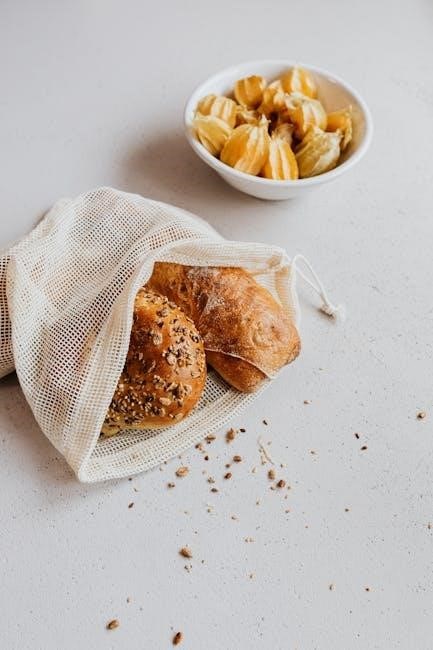Laucke Crusty White Bread Mix is a convenient and high-quality baking solution for homemade bread. This mix simplifies the bread-making process‚ ensuring a delicious‚ crusty loaf every time.
Overview of the Product
Laucke Crusty White Bread Mix is a pre-mixed blend designed for easy bread making at home. It contains high-protein wheaten flour‚ ensuring a robust structure and crispy crust. The mix is versatile‚ suitable for crafting various bread types such as crusty loaves‚ rolls‚ and pizza bases. Perfect for both novice and experienced bakers‚ it simplifies the bread-making process by requiring only a few additional ingredients like water‚ yeast‚ and olive oil. This mix is ideal for those seeking consistent results without the hassle of measuring multiple components.
Popularity and Usage
Laucke Crusty White Bread Mix is widely popular among home bakers and professionals alike for its ease of use and consistent results. It is a favorite choice for creating crusty loaves‚ rolls‚ pizza bases‚ and baguettes. The mix is versatile and ideal for both novice bakers and experienced enthusiasts. Its popularity stems from the convenience it offers‚ requiring minimal additional ingredients while delivering a delicious‚ authentic bread experience. Many users appreciate its ability to produce professional-quality bread with minimal effort‚ making it a staple in many kitchens for various baking needs.
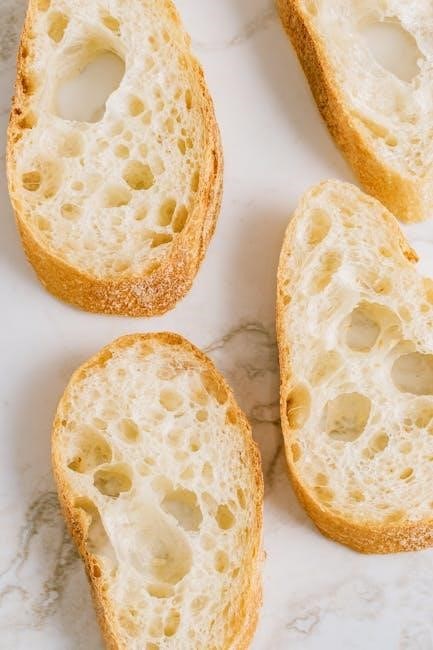
Key Features of the Mix
Laucke Crusty White Bread Mix is a high-quality‚ convenient baking solution designed to produce authentic crusty bread with minimal effort. Made from high-protein wheaten flour‚ it ensures a light interior and a crispy crust. The mix includes yeast and salt‚ eliminating the need for additional ingredients. Its versatility allows it to be used for rolls‚ pizza bases‚ and baguettes‚ making it a versatile choice for various baking needs. Perfect for both novice and experienced bakers‚ it delivers consistent results and professional-quality bread with ease.
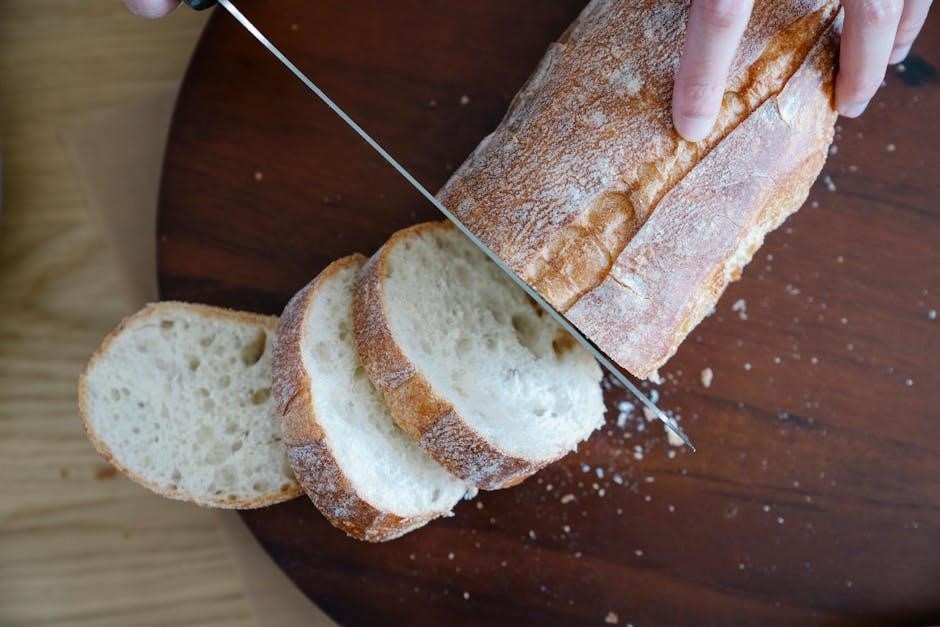
Ingredients Required
Laucke Crusty White Bread Mix‚ lukewarm water‚ dried yeast‚ and olive oil are the primary ingredients needed. Optional salt can be added for extra flavor enhancement.
Laucke Crusty White Bread Mix
Laucke Crusty White Bread Mix is a pre-blended mixture of high-protein wheaten flour‚ yeast‚ and salt‚ designed to produce a light‚ airy interior and a crunchy crust. This convenient mix simplifies bread making by combining essential ingredients‚ ensuring consistent results. It is ideal for creating crusty loaves‚ rolls‚ and pizza bases. The mix is versatile and can be used in bread makers or mixed by hand‚ making it accessible for both novice and experienced bakers. Its high-quality formulation guarantees a professional finish with minimal effort required.
Lukewarm Water
Lukewarm water is a crucial ingredient when using the Laucke Crusty White Bread Mix. It should be at a temperature of approximately 38°C to activate the yeast effectively without killing it. Typically‚ 350-380ml of lukewarm water is required‚ depending on the recipe. Ensuring the water is not too hot or cold is essential for proper yeast activity‚ which directly impacts the rise and texture of the bread. This step ensures the dough comes together smoothly and ferments evenly‚ leading to a light and crusty loaf.
Dried Yeast
Dried yeast is a fundamental ingredient in the Laucke Crusty White Bread Mix recipe‚ typically requiring 2 teaspoons or 1 sachet. It is essential for fermentation‚ producing carbon dioxide and creating the bread’s light‚ airy texture. Combine the yeast with the bread mix before adding water‚ ensuring the water is lukewarm (around 38°C) to activate the yeast effectively. Proper yeast activation is crucial for a crusty loaf with a well-risen structure. Measure the yeast accurately to avoid over- or under-proofing the dough‚ which can affect the final texture and flavor of the bread.
Olive Oil
Olive oil plays a key role in the Laucke Crusty White Bread Mix recipe‚ adding moisture and flavor to the dough. Typically‚ 1 tablespoon of olive oil is required‚ ensuring the bread remains soft and tender while enhancing its crusty texture. Use high-quality olive oil for the best results‚ as it contributes to the overall richness of the loaf. The oil is combined with water and yeast during the mixing process‚ creating a smooth‚ pliable dough that proofs evenly and bakes to perfection. This step is vital for achieving the desired consistency and taste in your homemade bread.
Optional Salt
Salt is an optional ingredient when using the Laucke Crusty White Bread Mix‚ allowing for personal taste preferences. While the mix already contains some salt‚ adding a pinch can enhance flavor and texture. If desired‚ sprinkle a small amount into the dough during mixing for extra depth. However‚ omitting salt is perfectly fine‚ especially for those monitoring sodium intake. The choice to include salt is entirely up to the baker‚ making the recipe adaptable to various dietary needs while maintaining its crusty‚ delicious outcome.
Preparation and Mixing
Combine Laucke Crusty White Bread Mix with yeast‚ then gradually add lukewarm water and olive oil‚ mixing until a smooth dough forms. Prove and shape as desired.
Gathering Ingredients
To start‚ gather all necessary ingredients: 600g of Laucke Crusty White Bread Mix‚ 1-2 cups of lukewarm water‚ 2 teaspoons of dried yeast‚ and 1 tablespoon of olive oil. Ensure the water is at 38°C for optimal yeast activation. Optionally‚ add a pinch of salt for extra flavor. Measure each ingredient accurately to achieve the best results. Having all components ready simplifies the mixing process and ensures a smooth workflow in preparing the dough.
Combining Bread Mix and Yeast
In a large mixing bowl‚ pour in the 600g Laucke Crusty White Bread Mix. Add 2 teaspoons of dried yeast‚ ensuring it’s evenly distributed throughout the mix. This step is crucial for activating the yeast‚ which will give your bread its rise. Use a whisk or spoon to gently combine the ingredients‚ creating a uniform blend. Avoid overmixing at this stage‚ as the dough will develop further during the kneading process. This combination sets the foundation for a light‚ airy interior and a crusty exterior.
Adding Water and Olive Oil
Gradually pour in 1-2 cups of tepid water (around 38°C) into the bowl with the bread mix and yeast. Add 1 tablespoon of olive oil‚ which helps moisturize the dough and enhances flavor. Mix the ingredients slowly until they form a shaggy dough. Ensure the water is evenly distributed‚ but avoid overmixing at this stage. The dough should be soft and slightly sticky; adjust with a little more water if needed. This step prepares the dough for kneading‚ which will develop the gluten for a crusty texture and airy interior.
Mixing the Dough
Combine the bread mix‚ yeast‚ and a pinch of salt in a large bowl. Gradually add 350-380ml of lukewarm water‚ mixing until a dough forms. Use a stand mixer with a dough hook attachment or mix by hand. Knead for 6-10 minutes until smooth and elastic. Avoid overmixing to prevent dense bread. The dough should be soft and slightly sticky. If using a machine‚ start at low speed‚ then increase. Proper mixing ensures even hydration and develops gluten‚ essential for a crusty texture and airy interior. Stop once the dough comes together in a cohesive ball.
Proving the Dough
Once mixed‚ place the dough in a lightly oiled bowl‚ turning it to coat evenly. Cover with plastic wrap or a damp cloth. Let it rest in a warm‚ draft-free area for 30-40 minutes‚ or until doubled in size. Ensure the environment is not too hot‚ as this can over-proof the dough. Humidity aids in even rising. Avoid disturbing the dough during this time. The proving stage is crucial for developing the bread’s texture and crust. Over-proving can lead to a dense final product‚ so monitor closely to achieve the perfect rise before shaping.
Shaping the Dough
After proving‚ gently press down the dough to release air. Turn it onto a lightly floured surface and knead lightly. Shape into a round‚ oblong‚ or long loaf‚ depending on your preference. For a crusty loaf‚ ensure the surface is smooth and even. Place the dough onto a baking tray lined with parchment paper‚ leaving space for expansion. Optional additions like sesame seeds can be brushed onto the surface. Shaping is crucial for achieving the desired crust texture and even baking. Handle the dough gently to avoid deflating it excessively‚ ensuring a light interior and crispy crust.
Baking the Bread
Preheat your oven to 210°C (410°F) with humidity at 30%. Bake the shaped loaf for 25-30 minutes‚ or until golden brown with a crispy crust. Let cool slightly before slicing for the best results.
Preheating the Oven
Preheat your oven to 210°C (410°F) with humidity set to 30% for optimal results. Ensure the oven is fully preheated before placing the dough inside. For a crispy crust‚ place a baking stone or tray in the oven during preheating. Proper preheating ensures even baking and helps develop the bread’s crust. Allow the oven to reach the desired temperature for at least 15-20 minutes before baking. This step is crucial for achieving the perfect crusty texture of your homemade bread using the Laucke Crusty White Bread Mix.
Baking the Loaf
Gently place the shaped dough onto a preheated baking stone or oven tray. Bake at 210°C (410°F) with 30% humidity for 25-35 minutes‚ or until golden brown. Avoid opening the oven during the first 20 minutes to ensure proper rising. The loaf is ready when it sounds hollow when tapped on the bottom. For a crisper crust‚ bake for an additional 5 minutes. Remove and let cool on a wire rack to prevent sogginess. This step ensures a perfectly baked‚ crusty loaf every time using the Laucke Crusty White Bread Mix.
Cooling the Bread
Once baked‚ remove the loaf from the oven and immediately place it on a wire rack to cool. This step is crucial to prevent sogginess and retain the crust’s crispiness. Allow the bread to cool completely before slicing or storing. Cooling on a wire rack ensures even air circulation around the loaf. Avoid wrapping the bread while it’s still warm‚ as this can trap moisture and soften the crust. Letting it cool thoroughly also helps the bread develop its final texture and flavor. Proper cooling ensures your crusty loaf stays fresh and delicious.
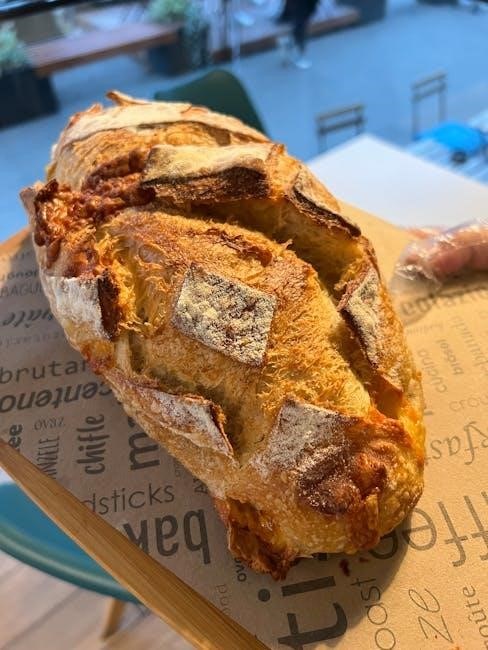
Tips for Perfect Results
Ensure water is at the right temperature‚ not too hot or cold. Use the correct yeast amount for optimal rise. Avoid overmixing dough for a tender crumb. Lightly oil surfaces to prevent sticking. Handle dough gently to maintain air pockets for a fluffy interior and crispy crust. These tips enhance texture and flavor‚ ensuring your bread turns out perfectly every time.
Ensuring the Right Water Temperature
Using lukewarm water is crucial for activating yeast and achieving the perfect rise. Water that is too hot can kill the yeast‚ while cold water may slow fermentation. Ideal water temperature ranges between 35°C to 40°C (95°F to 104°F). To check‚ drizzle a small amount onto the inside of your wrist—it should feel warm but not scalding. If unsure‚ use a thermometer for accuracy. Proper water temperature ensures active yeast growth‚ leading to a light‚ airy texture and a well-risen crusty loaf. This step is essential for achieving professional-quality bread at home.
Creating a Crispy Crust
Achieving a crispy crust requires precise baking techniques. Preheat your oven to the highest temperature (around 220°C) and ensure it is thoroughly heated. Placing a tray of water in the oven creates steam‚ which enhances crust crispiness; Score the bread lightly before baking to control crack formation. Bake for 25-35 minutes‚ or until golden brown. Avoid overbaking‚ as it can dry out the bread. A well-baked crust should be golden‚ firm‚ and crackle when tapped. These steps ensure a professional-quality crust for your homemade loaf.
Optional Additions for Flavor
Elevate your bread’s flavor by incorporating optional ingredients into the dough. Herbs like rosemary or thyme‚ spices such as garlic powder‚ or grated cheese can add unique twists. For a nutty flavor‚ try adding sesame or poppy seeds. Simply mix these ingredients into the dough during the initial stages of preparation. You can also brush the loaf with olive oil or butter before baking for a richer taste. These additions allow you to customize the bread to your preferences‚ making each batch truly special and delicious.
Troubleshooting Common Issues
Common issues with bread making include dense texture‚ too-dry dough‚ or poor rise. These are often caused by incorrect water temperature‚ overmixing‚ or insufficient yeast activity. Addressing these factors can help achieve better results.
Why the Bread Might Be Too Dense
Bread turning out too dense can result from overmixing the dough‚ which develops excess gluten‚ or using insufficient yeast‚ leading to poor rise. Incorrect water temperature‚ either too hot or too cold‚ can disrupt yeast activity. Additionally‚ using too much flour or not enough water can create a dense texture. Ensuring the right balance of ingredients and gentle mixing helps achieve a lighter‚ airier loaf. Checking yeast expiration and maintaining proper proving conditions are also crucial for optimal results.
Fixing a Too-Dry Dough
If the dough feels too dry‚ it may be due to insufficient water or excessive flour. Gradually add small amounts of lukewarm water‚ mixing gently until the dough reaches the desired consistency. Avoid overmixing‚ as this can lead to a dense texture. If the dough remains dry‚ check the mix for accurate measurements and ensure yeast is active. Folding the dough lightly after adding water can help restore moisture without developing excess gluten‚ resulting in a smoother‚ more pliable texture for baking.
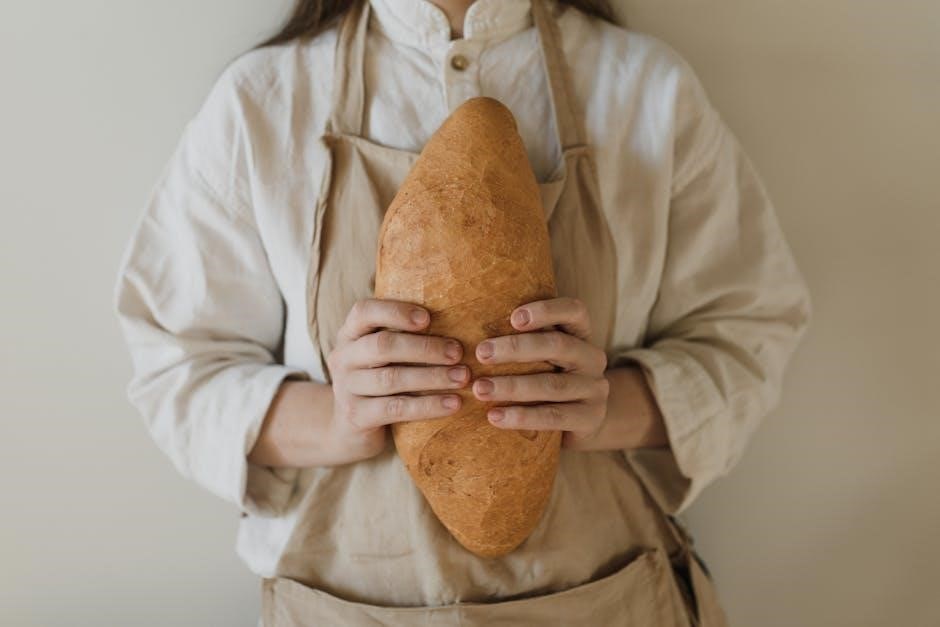
Related Recipes and Uses
Laucke Crusty White Bread Mix is versatile for creating rolls‚ pizza bases‚ and baguettes‚ offering a variety of delicious bread options beyond traditional loaves.
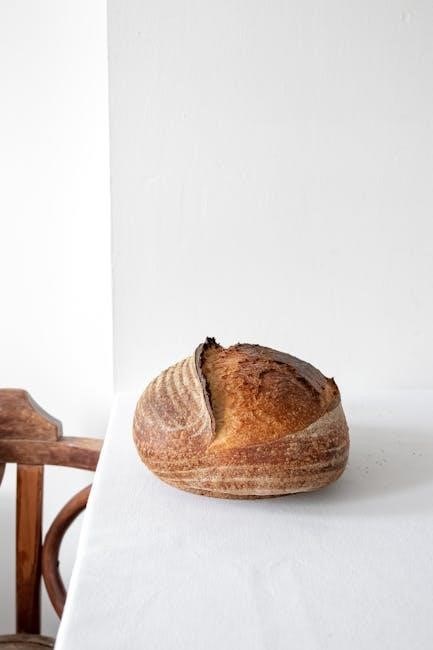
Using the Mix for Rolls
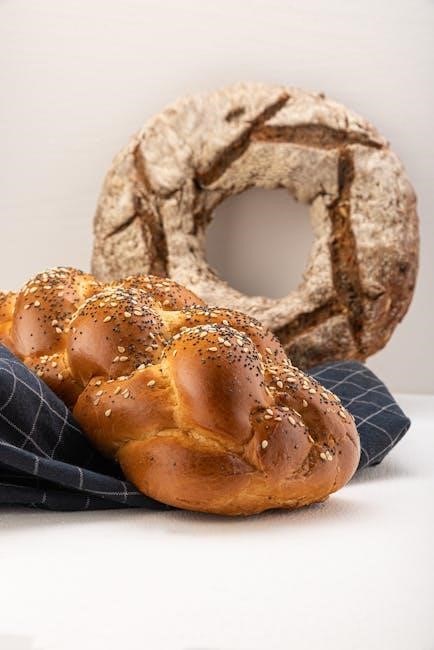
Transform Laucke Crusty White Bread Mix into soft‚ delicious rolls by following a simple adaptation of the bread-making process. After mixing the dough as instructed‚ divide it into smaller portions. Shape each portion into a ball or desired roll shape. Place the rolls on a baking tray lined with parchment‚ leaving space for expansion. Bake at 200°C for 15-20 minutes‚ or until golden brown. This method yields perfect‚ crusty-on-the-outside and fluffy-on-the-inside rolls‚ ideal for sandwiches‚ snacks‚ or serving alongside meals.
Making Pizza Bases
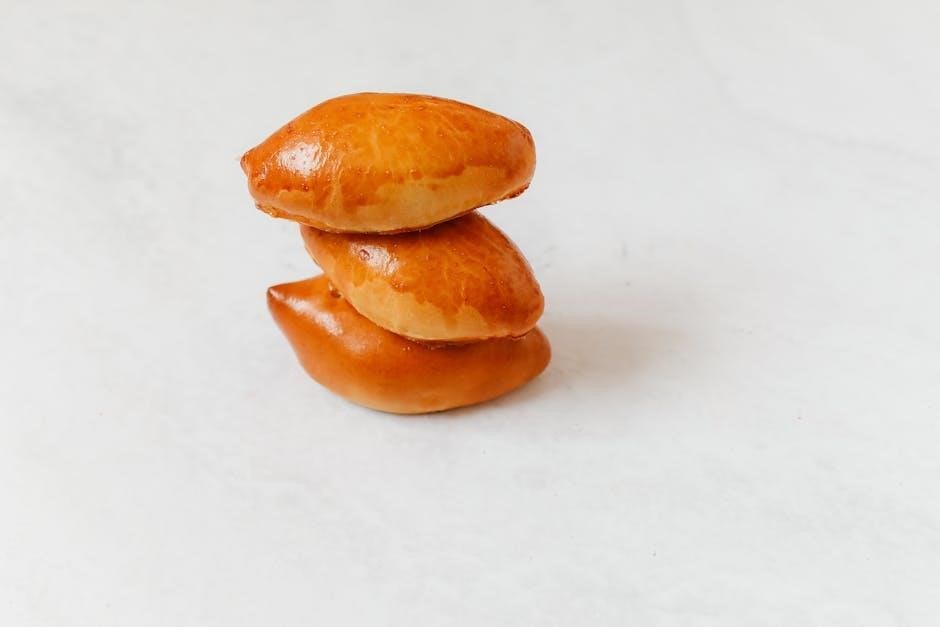
Laucke Crusty White Bread Mix is an excellent choice for making delicious homemade pizza bases. Simply prepare the dough as instructed‚ then divide it into portions based on the size of pizza you prefer. Roll out each portion thinly to form your desired shape‚ whether circular or rectangular. Bake the bases in a preheated oven at 220°C for 5-7 minutes‚ or until lightly golden‚ before adding your favorite toppings. This method ensures a crispy crust and a flavorful base‚ perfect for customizing with your preferred ingredients.
Creating Baguettes
Laucke Crusty White Bread Mix is perfect for crafting authentic French-style baguettes. After preparing the dough as instructed‚ divide it into long‚ thin portions and shape into traditional baguette forms. Allow the dough to rise‚ then bake in a hot oven at 220°C for 15-20 minutes‚ or until golden brown. The result is a crispy‚ golden crust with a light‚ airy interior‚ capturing the essence of French baguettes with minimal effort and exceptional flavor.
